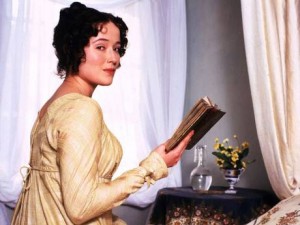Making Appointments With (Fictional) Doctors
A fictional M.D. will not reduce your fever, but she or he might reduce your boredom. That’s because many medical protagonists — whether general practitioners or something else — are quite interesting. They’re often not liberal arts types, but, heck, non-liberal arts types can be compelling characters, too.
Also of interest is seeing how fictional physicians interact with fictional patients, and how these doctors manage their fictional personal lives while working long hours. Plus we can’t help comparing literature’s doctors to our own doctors. Are these made-up medical people as compassionate and dedicated, or as egotistic and mercenary, or as competent or not-so-competent as the real-life medical people we visit?
Read what Dave Astor has to say about doctors in fiction, from Flaubert’s Madame Bovary to John Grisham’s The Client.
Romance that never loses its sparkle: The world’s most influential novel ever

It gave us Colin Firth in a clinging, wet shirt and inspired Bridget Jones to sing “I’m Every Woman”. Jane Austen’s “own darling child”, or Pride and Prejudice as it’s known to you and me, is a brand all of its own. It has inspired more spin-offs than almost any other book in history, and has ballooned into a multi-million-pound industry. Pretty impressive, considering it turns 200 years old this month.
As enthusiasts, academics, authors and film-makers across the globe celebrate the bicentenary of the novel’s publication in the next few weeks, experts suggest “cult Austen” is only going to get bigger. Its market, they say – which until now has consisted largely of Britain, the US and Australia – is expanding. China, India and Russia are starting to swot up on all things Austen. Visitors are flocking to visit her home, Chawton in Hampshire, to read the sequels and travel to the locations where adaptations of her works were filmed.
Notes on all kinds of artistic endeavors inspired by Pride and Prejudice.
Fact of fiction: How reading the classics gives the brain a boost
Researchers at Liverpool University believe that reading classic works of literature, particularly Shakespeare, “had a beneficial effect on the mind, by catching the reader’s attention and triggering moments of self-reflection.”
Using scanners, they monitored the brain activity of volunteers as they read pieces by Shakespeare, Wordsworth, TS Eliot and others. They then “translated” the texts into more “straightforward”, modern language and again monitored the readers’ brains as they read the words. Scans showed that the more “challenging” prose and poetry set off far more electrical activity in the brain than the more pedestrian versions.
Scientists were able to study the brain activity as readers responded to each word and noticed how it “lit up” as they encountered unusual words, surprising phrases or difficult sentence structure. This “lighting up” of the mind lasted longer than the initial electrical spark, shifting the brain to a higher gear and encouraging further reading.
The classics also produced self-appraisal in readers:
The research also found that poetry, in particular, increased activity in the right hemisphere of the brain, an area concerned with “autobiographical memory”, helping the reader to reflect on and reappraise their own experiences in light of what they had read.
One aspect of the research compared the reactions in volunteers’ brains when reading the work of, among others, Wordsworth, Henry Vaughan, John Donne, Elizabeth Barrett Browning, Eliot, Philip Larkin and Ted Hughes and when reading paraphrases of the poetic passages. Reading of the original passages
caused a greater degree of brain activity, lighting up not only the left part of the brain concerned with language, but also the right hemisphere that relates to autobiographical memory and emotion.
Activity is this area of the brain suggests that the poetry triggers “reappraisal mechanisms” causing the reader to reflect and rethink their own experiences. “Poetry is not just a matter of style. It is a matter of deep versions of experience that add the emotional and biographical to the cognitive,” said Prof [Philip] Davis [an English professor who worked on the study].
“The next phase of the research is looking at the extent to which poetry can affect psychology and provide therapeutic benefit.”
Five Movies Coming Out In 2013 That Are Based On Books
Freelance writer and photographer Kristina Pino provides a heads-up on some upcoming films. “This list isn’t about the likes of Ender’s Game, Hunger Games, Carrie, The Great Gatsby, The Host, and others. It’s about the ‘little guys.'”
Read why she recommends these films:
- Warm Bodies
- The Reluctant Fundamentalist
- Beautiful Creatures
- I, Frankenstein
- Epic
Meet Babies Grey and Anastasia: ‘Fifty Shades of Grey’ inspires baby names
Call it the Fifty Shades bump — literally. BabyCenter has released their yearly list of most popular baby names and — shocker! — the Class of 2030 will be seeing a lot more Anastasias and Greys. Wait, Greys? Yes, readers. When bestowing a Fifty Shades-inspired moniker on their child, parents chose not Christian, but Grey. The name saw a 20 percent jump from last year. On the girls’ side of things, Anastasia rose ten percent, while Ana climbed 35 spots.
Movies Are Literature Too
And for snooty readers who think the book is always better than the movie, Christina Oppold has some news:
Sometimes we take our lives as readers too seriously. Even if we flit between the highbrow and fluffy beach read, it is easy to think of books as somehow being superior to movies. But storytelling is all connected. From the camp fire to the Blue Ray DVD, from stone tablets to digital ink; what thrills the balletomane bores the cinephile. Each new medium follows on the heels of what came before; it breathes new life in to sharing our stories and each is belittled by the supporters of what came before.
We read not for the sake of the book as a physical object but for the stories within that move us. Embrace the story no matter how it was conveyed to you.
